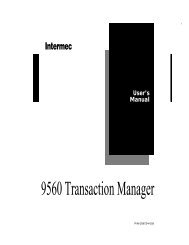Contents, cont'd. - Intermec
Contents, cont'd. - Intermec
Contents, cont'd. - Intermec
You also want an ePaper? Increase the reach of your titles
YUMPU automatically turns print PDFs into web optimized ePapers that Google loves.
COUNT&<br />
Chapter 2 Program Instructions<br />
Field of Application Statement for creating a counter (<strong>Intermec</strong> Direct Protocol only).<br />
Syntax COUNT& ,,<br />
is the type of counter parameter to be set:<br />
START (start value)<br />
WIDTH (minimum number of digits)<br />
COPY (number of copies before update)<br />
INC (increment/decrement at update)<br />
STOP (stop value)<br />
RESTART (restart counting at this value)<br />
is the counter reference number (integers only).<br />
is the parameter value.<br />
Remarks This instruction can only be used in the <strong>Intermec</strong> Direct Protocol.<br />
The counters can be used in text and bar code fields and are global, i.e. they<br />
are not connected to any special label or layout, but will be updated at every<br />
execution of PRINTFEED statements where the counter in question is used.<br />
Counters are designated using positive integers, e.g. 1, 2 or 3. When used for<br />
printing, they are referred to by “CNT$” variables, where <br />
is the number of the counter as specified by COUNT&, e.g. CNT5$.<br />
A counter variable without a matching counter will be regarded as a common<br />
string variable.<br />
The value of the start, stop, and restart parameters decide the type of counter<br />
(alpha or numeric). If different types of counter are specified in these<br />
parameters, the last entered parameter decides the type. Alpha counters count<br />
A–Z whereas numeric counters use numbers without any practical limit.<br />
Counters are not saved in the printer's memory, but will have to be recreated<br />
after each power up. Therefore, it may be wise to save the COUNT&<br />
statements as a file in the host.<br />
START:<br />
Decides the first value to be printed. If a single letter is entered (A–Z), the<br />
counter will become an alpha counter, and if one or several digits are entered<br />
the counter will be numeric.<br />
Numeric values can be positive or negative. Negative values are indicated by<br />
a leading minus sign.<br />
Default: 1 (numeric) or A (alpha)<br />
WIDTH:<br />
This parameter can only be used in numeric counters and decides the<br />
minimum number of digits to be printed. If the counter value contains a lesser<br />
number of digits, leading zero (0) characters will be added until the specified<br />
number of digits is obtained. If the number of digits in the counter value is<br />
equal to or larger than specified in the width parameter, the value will be<br />
printed in its entity.<br />
Default: 1 (i.e. no leading zeros)<br />
<strong>Intermec</strong> Fingerprint 7.2 – Reference Manual Ed. 3 50
















